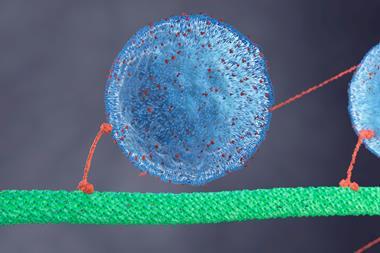I do not recognise the picture of dug discovery at the ’coal-face’ painted by Clare Sansom and her sources in the article Molecules made to measure (Chemistry World, November 2009, p50)
I worked at Roche UK (Roche Research Centre, Welwyn Garden City, Herts) as a young medicinal chemist in the 1970s and watched with great excitement the first efforts on computer assisted molecular modelling and drug design using protein structures derived from x-ray crystallography. This was a collaboration between the late Toni Kr?hn, our UK computational chemist, and chemists in Roche Basle on dihydro folate reductase. The value of the technology was apparent to all and led to an explosion of activity across the whole industry, which has been maintained to the current day. It started with major efforts on proteases like renin, thrombin, and the MMPs and then the viral proteases from HIV and HCV but included many other enzymes such as influenza neuraminidase, of particular relevance these days with swine flu.
Protein crystallography has provided enormously valuable insights over the past 30 years, using both crystal structures and homology models of family members, in many areas of drug discovery: kinases, nuclear hormone receptors, t-RNA synthetases, proteases such as cathepsin K and beta-secretase to name but a few. Now in the last few years, structures of even ion channels and mammalian GPCRs have been solved. ’Resolutely out of fashion in the 1990s?’ Absolutely not in the companies I worked for (Roche, SmithKline Beecham, GSK). Resolutely in fashion, throughout the past 30 years and supported to the hilt with people and kit.
Advances in technology have also played a big role. Automation of crystallisation realized a huge increase in productivity and access to national synchrotron facilities enabled the generation of new structures using very small crystals. All of this has reduced the turn around time from months to days and made crystallography part of the routine ’design it, make it, test it’ cycle.
But it doesn’t always work. What about all those important targets where protein crystallography fails to help? High-throughput screening (HTS) and the use of historical company compound collections and compound libraries designed for diversity or based on privileged structures for particular protein families have provided the chemical ’hits’ for many development candidates. Examples such as the marketed drugs maraviroc (CCR-5 antagonist for HIV; Pfizer) and eltrombopag (small molecule thrombopoietin receptor agonist for thrombocytopenic disorders; GSK/Ligand) are groundbreaking first-in-class medicines that resulted from this screening approach to hit identification.
Of course, HTS doesn’t always work either. There are no panaceas for successful drug discovery. It is all about choosing the most appropriate tools for the job, to get to the development compound, as quickly as possible. Fashion doesn’t come into it.
And what about saquinavir, the first HIV protease inhibitor to market? It is not obvious from Sansom’s article but this is a great British invention. Whilst much of the molecular biology, molecular virology and protein crystallography was done in both Roche Basle and Roche Nutley, all the drug design/medicinal chemistry, the biochemistry, and virology was carried out in Welwyn at the Roche Research Centre. The compounds were based on some (poor) renin inhibitors, also designed in Welwyn in the late 1970s, that allowed easy incorporation of proline and proline analogues into the transition state mimetic that gives the series its superb selectivity for HIV protease over the mammalian aspartyl protease family. Homology models, using the ’dimer’ hypothesis, were built by Toni Kr?hn long before the actual x-ray structure was available either in-house or in the literature. Using our experience of protease inhibitor design, knowledge of HIV biochemistry and models of the enzyme structure, we generated the series of inhibitors that culminated in saquinavir. Patents were filed in 1988, more than six months before the first structure was published.
It’s a great story and was a very exciting and satisfying piece of drug discovery and, I agree, we should all be very proud of the way the community (industry and academia) marshalled its forces to rapidly generate a whole family of effective therapeutics in the face of such a terrifying disease as HIV/Aids.
P J Machin FRSC
London UK
I recently read with some sadness about the impending closure of the Edinburgh offices of Chambers-Harrap (owned by Hachette) and the consequent threat to the much-loved Chambers dictionary, considered by many (including Scrabble players) as the gold standard of dictionaries.
This dictionary, strangely enough, played a part in my growing interest in chemistry as a child. My copy of Chambers in the 1950s included molecular formulae for each chemical name defined. I used to learn these formulae by heart, until my older brother told me that the exercise was pointless - to know that the molecular formula of glucose was C6H12O6 told the reader of the dictionary nothing as to the structure of the molecule.In time, someone must have mentioned this to Chambers since the molecular formulae disappeared in subsequent editions.
Let’s hope that the Chambers dictionary has a future in these days of online dictionaries, even if not as a source of molecular formulae.
H Kidd
Cambridge, UK
The letter from Mike Thayer (Chemistry World, December 2009, p43) mirrors my own experience in the 1940s. I too studied at Bristol’s Merchant Venturers Technical College (later College of Technology) for seven years to obtain first ONC, HNC and finally ARIC by external examination in London in 1951. I recall the post-war rush for all college enrolments in 1945 in bomb-scarred Bristol resulting in queues for 100 yards outside MVTC’s doors.
Our tutors were mostly college staff but several came from industry. Most of my course was at night school but at HNC level I managed some part-time studies. My problem was working in Swindon as a junior chemist in the GWR chemistry laboratory, some 45 miles from Bristol. The railway ticket was however provided by my employer. For my college education I travelled over 51 000 miles to qualify.
When I left the then nationalised GWR lab in 1951 after seven years chemistry experience I was earning about ?260 a year - the youngest, lowest paid, but highest qualified chemist. I then spent seven years in four CEGB power plants as station chemist followed by 33 years with the UKAEA.
G C W Comley CChem FRSC
Dorchester, UK
I write as a professor working for a national university [Nagoya] and helping with the internationalisation of the campus. Currently, we are busy planning the Global 30 initiative as we will launch select programmes in English starting in October 2011. When we were chosen as one of 13 universities to actively participate in this 300 000 International Student Plan (to be achieved by 2020), the first thing we did was to put together a list of our competitive advantages. You see, the ramifications of offering courses in English are quite profound and needless to say, global; for essentially, we will be opening up our university to compete with all the other English curriculums of the world. In today’s environment, with competition coming from all corners, if an organisation does not clearly understand its competitive advantages and have this as the cornerstone of its strategic plan, it will be a thing of the past in no time.
In recent years, Japan has been losing her leadership in the world and within Asia to countries like China and India. Yet, when you ask any foreigner, many still view Japan as one of world leaders in the areas of science and technology. This is apparent from the cars made by Toyota and Honda, cameras made by Canon, and the N700 bullet-train that we take for granted being accurate to the second. However, as government budgets are currently being reviewed, bureaucrats who seemingly have no clue as to how certain programmes are strategic to a country’s competitive advantage, are making a spectacle of this process, recklessly diddling with abstract numbers with no inkling that they are effectively throwing away Japan’s strengths that are critical to competing in this ruthless global marketplace.
In the last few months, there has been a rash of articles on how governments around Asia are pumping more money particularly into their higher educational institutions. In the October 5th issue of the Chronicle of Higher Education, a special titled, ’Asia rising: countries funnel billions into universities,’ profiled China, Taiwan, South Korea, Hong Kong, and Singapore, with Japan visibly absent. Earlier this year, India increased its education budget by an unprecedented 40 per cent to US$3.1 billion for fiscal year 2009-2010. Four years earlier in 2005, Taiwan pegged US$1.6 billion to its top universities with the goal of having 10 of Asia’s top universities or programs by 2010. All these countries are aggressively internationalising their higher educational institutions as they compete in the global market for talent. Governments of these countries probably understand that education is critical in cultivating their human resources and how this plays a strategic role for their future. Yet, Japan seems to be going the other way, proposing to cut education-related budgets simply to meet the US$3 trillion in cuts the current administration promised during their campaign. What’s worse is Japan is doing this with the knowledge that there will be a shortage of 17 million workers to keep the economy going at current levels in 2050. Some analysts at think-tanks have said that Japan’s single most ominous issue is the decreasing birth rate coupled with the ever-increasing elderly population.
Before this reckless carnage of budget cuts morphs into a monster that could catastrophically end what’s left of Japan’s leadership in this world, we need more prominent leaders to stand up and voice their opinions where it counts, as some of Japan’s Nobel Laureates did in December 2009. More than ever, Japan needs strategic-minded leaders who understand where and how things are connected, to negotiate with government officials that critical areas such as the educational budget need to be augmented, particularly now when Japan sees her leadership slipping. Like an organisation, a country must do whatever it takes to fiercely guard her competitive advantages to survive.
In closing, as a foreigner having lived in Japan for over three years, I have seen that there are many great things about this country. As an outsider who has travelled extensively, I still view Japan as being one of the leaders in the sciences and technology. I have been fortunate to experience the cutting edge technology of the Shinkansen, to have used the out-of-this-world Tokyo Bay Aqua-Line connecting Tokyo with Chiba, and to be witnessing the expansion of the improved Haneda airport utilising leading-edge methods.
Nagoya University has played an integral role in cultivating the scientists and engineers of this nation. As we embark to compete with the top universities of the world, we need the government’s backing both in terms of budget and with the strategic vision for this nation, to be in line with the pressing issues we face, and to fearlessly guard and augment Japan’s competitive advantages for her survival.
G Yoshida
Japan
I read with some interest the comments by Gerald Booth on water production in combustion and its entry into the environment (Chemistry World, December 2009, p42). In fact I myself earlier in the year published simple, approximate calculations to the effect that:
1 barrel of oil burnt → 1 barrel of water entering the environment
I went on to argue that the resulting daily addition of water to the environment is an order of magnitude higher than the daily water requirement of London. I have also used these calculations in my teaching at Aberdeen and can make details of them available on request to any reader of Chemistry World.
J C Jones FRSC
Aberdeen, UK
Interesting to read the two cultures debate being aired again in Diana Hendry’s article on Poetic Science (Chemistry World, November 2009, p41). Here’s something I prepared earlier (I’m sure Chemistry World readers can do better):
Authors note...With sincere apologies to William Blake! -
Benzene! Benzene! Burning bright
Belching engines day and night (1)
What immortal hand or eye
Could frame Kekulé’s symmetry? (2)
Who’d have thought your Carbon Six
Could have produced such toxic tricks
Or provide the building blocks
For a plastic world (and cure the pox)?
Aesthetic, perfect aromatic
Substitutes produce chromatic
Dyes that brighten every day. (3)
Thankyou Mr Faraday. (4)
Clothe our backs (5) and cure our ills
Blow or dull our brains with pills (6)
Ironic that your homologues
Pollute our land and stock our smogs (7)
Benzene - your hydroxyl daughters
Need locking up, they pollute our waters (8)
Adding chlorine provides persistence (9)
(Target organs keep your distance).
Doubt Kekulé ever dreamt
Of such riches (or torment).
Oh benzene whether bound or free
Did He who made the Lamb make Thee ?
Benzene! Benzene! Burning bright
Belching engines day and night
What immortal hand or eye
Could frame Kekulé’s symmetry ?
- Benzene is a significant constituent of petrol
- Friedrich August Kekulé (1829-96) is attributed with elucidating the symmetrical ring structure of benzene C6H6 , claiming as an old man that the idea of the carbon chain had first occurred to him in the summer of 1854 on top of a London omnibus, although the matter remains controversial
- Many synthetic dyes are based on substituted benzene molecules such as aniline,C6H5NH2
- His portrait used to be found on the back of an old UK twenty-pound note. If you can get to London, England, you can see Michael Faraday’s laboratory too, just off Piccadilly, at the Michael Faraday Museum
- Benzene is used in the production of artificial leather.
- Benzene is used in the manufacture of medicinal chemicals.
- Benzene is a known carcinogen and can pollute both the air we breathe and the land we live on.
- Phenols (benzene substituted with OH groups) and related compounds are particularly hydrophilic (water loving) and pollute our waterways.
- Organochlorines such as organochlorine pesticides (DDT is an example) and polychlorinated biphenyls (PCBs) do not readily break down in the environment and tend to bioaccumulate due to their lipophilicity (affinity for fat)
P Board CChem FRSC
Conwy, UK
It comes to my mind that the educational basis of teaching organic synthesis should put more emphasis on physics, besides chemistry.
The early development of organic synthesis took place in the first half of the nineteenth century, when the great discoveries of physics, especially concerning electricity (Volta and Faraday), happened. Of paramount importance were the electrolytic experiments, especially of Berzelius, Davy and Faraday, which led to, respectively: discovery of chlorine and the alkali metals by Davy; the dualistic electrochemical theory of the chemical bonding of Berzelius; and the quantitative theory of electrochemical reactions by Faraday. The application of chlorine and alkali metals made possible the first truly synthetic reactions in organic chemistry. Berzelius’ theory, finally refuted, allowed the establishment of the structure of organic compounds. The experimental determinations of Faraday, being at the base of his theory, led to a precise scale of chemical equivalents, and finally to true atomic and molecular masses.
Other examples of the role of physics in the development of organic synthesis can be further cited. The idea has been presented in a textbook.
R Sioda
Warszawa, Poland












No comments yet